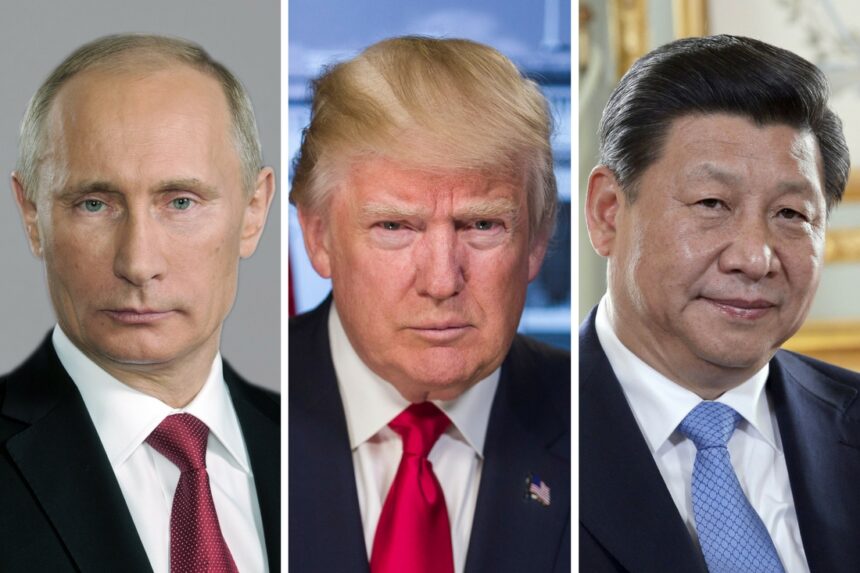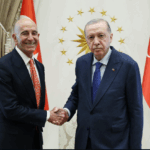In an interview with Tucker Carlson on October 31, 2024, Donald Trump promised to “un-unite” Russia and China, reviving a familiar Cold War impulse to play one great power off against the other. Echoing the logic that underpinned Richard Nixon and Henry Kissinger’s diplomatic opening to Maoist China, Trump seems to believe that a similar maneuver is still possible—and necessary—in the 21st century. But the world has changed, and so has the nature of the Sino-Russian relationship. Today, the foundations of that partnership run far deeper than the ideological divisions that once drove Moscow and Beijing apart. As such, Trump’s ambitions for a new strategic realignment are not just outdated—they are likely to prove counterproductive.
A Partnership of Purpose, Not Convenience
Since the announcement of their “no-limits” partnership in early 2022, just days before Russia’s full-scale invasion of Ukraine, China and Russia have moved into closer strategic alignment. This isn’t a fleeting alignment of interests or a tactical convergence. It is a long-term partnership grounded in a shared commitment to revising the existing U.S.-led international order.
Yes, the relationship is increasingly asymmetric—Russia is more dependent on China than the reverse—but that hasn’t eroded its strategic coherence. In 2024, bilateral trade hit a record $237 billion. China offers Moscow an indispensable economic lifeline, diplomatic cover at the United Nations, and coordination in areas like energy, defense, and digital governance. In turn, Russia remains useful to China as a strategic buffer, a fellow authoritarian regime with veto power on the UN Security Council, and a partner in undermining Western influence—particularly in the Global South.
To think that Moscow could be easily pried away from this relationship, even with offers such as favorable terms on Ukraine or sanctions relief, reflects a fundamental misunderstanding of how deeply embedded this partnership has become. It’s not just about short-term gains; it’s about long-term survival in a world they both view as increasingly hostile to their regimes.
The Incoherence of Trump’s Foreign Policy
Perhaps more damaging to Trump’s geopolitical aims is the nature of his own foreign policy. Rather than isolating China, Trump’s foreign policy, marked by isolationism, erratic diplomacy, and a disdain for multilateral institutions, created the very conditions in which China could extend its influence.
On one hand, Trump imposed tariffs, tightened export controls, and launched rhetorical assaults on China’s trade practices. On the other hand, he praised Xi Jinping, mused about striking a “grand bargain,” and hinted at scaling back U.S. commitments to Taiwan. This blend of aggression and admiration created a foreign policy that was as unpredictable as it was incoherent—raising concerns not just in Beijing, but among U.S. allies and partners around the world.
In contrast, China has positioned itself as a stable, predictable alternative. Beijing has mastered the art of soft power in the Global South, offering development financing, infrastructure investment, and rhetorical commitments to South-South solidarity—all with fewer political strings attached than those typically demanded by Washington or Brussels.
China’s Expanding Appeal in the Global South
The Global South is increasingly the arena where the future of geopolitical influence will be decided. Here, China is making inroads through a variety of initiatives: the Belt and Road Initiative (BRI), digital infrastructure investment, vaccine diplomacy, and development loans from institutions like the Asian Infrastructure Investment Bank. Many of these efforts are aimed at countries that have grown frustrated with Western conditionality and wary of the unpredictability of U.S. leadership.
In Africa, China remains the continent’s largest trading partner and a top source of infrastructure financing. In Latin America, Chinese companies are investing heavily in renewable energy, mining, and digital infrastructure. Even in Southeast Asia—where Beijing’s territorial ambitions in the South China Sea remain a source of tension—China’s economic weight is difficult to ignore.
The core appeal of China’s approach is its consistency. It rarely lectures. It doesn’t demand political reforms. And it frames its engagement in terms of multipolarity and mutual respect—messages that resonate powerfully in a post-colonial world still skeptical of Western interventionism.
Strategic Drift in the Transatlantic Alliance
Trump’s foreign policy has not only alienated the Global South, but it has also damaged America’s relationships with its most important allies in Europe and North America. His repeated attacks on NATO, his ambivalent attitude towards the EU, his threats of annexation towards Canada, and his use of tariffs and a transactional approach to diplomacy have all contributed to the strain on transatlantic ties.
Trump’s presidency could further diminish Europe’s confidence in U.S. strategic commitments. If the war in Ukraine ends with a U.S.-brokered peace deal that favors Russia, it may ease tensions between China and the EU and open space for a modest recalibration of their relationship. Dormant projects such as the EU–China Comprehensive Agreement on Investment could reemerge on the agenda, especially among member states looking to balance U.S. pressure with economic self-interest.
Countries like the Netherlands, home to critical semiconductor firms like ASML, have already expressed discomfort with Washington’s hardline stance on technology exports. Canada, too, has grown increasingly uneasy with Trump’s vision of Arctic geopolitics, which includes ambitious military plans but lacks the shipbuilding capacity or multilateral coordination to make them credible.
While a wholesale European or Canadian pivot toward Beijing is unlikely, Trump’s continued antagonism toward multilateralism may push traditional allies to diversify their strategic options—not necessarily to embrace China, but to hedge against a volatile and increasingly unreliable United States.
A Multipolar Future, Accelerated by American Hubris
The world Trump hopes to reshape no longer resembles the binary structure of the Cold War. The strategic clarity of the U.S.-Soviet rivalry has given way to a far messier landscape—one defined by economic interdependence, asymmetric power relations, and contested global governance. In this environment, efforts to revive Cold War-era strategies of triangulation are likely to fall flat.
Worse still, they may produce unintended consequences. Far from driving a wedge between Russia and China, Trump’s approach is reinforcing their alignment. Far from restoring American primacy, it is encouraging traditional allies to look elsewhere for stability. And far from sidelining China, it is accelerating its integration into a more multipolar international system—particularly in regions where U.S. influence has already begun to wane.
If anything, Trump’s foreign policy has become a catalyst for the very global transformation he seeks to resist. In trying to replay Nixon’s game, he may find that the rules—and the players—have fundamentally changed.
By: Geopolist | Istanbul Center for Geopolitics







